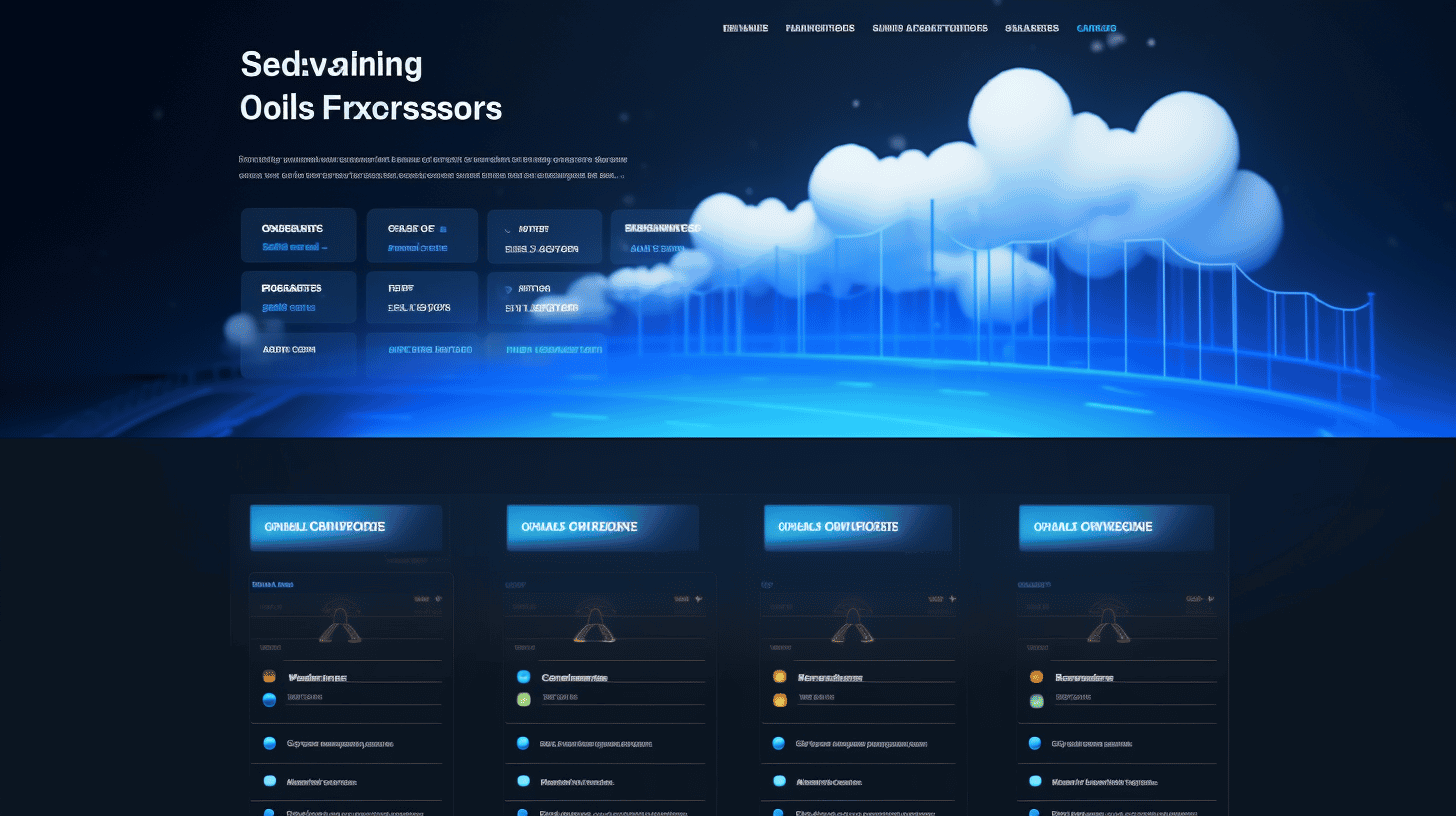在当今的数字环境中,拥有一个高性能的网站对于企业蓬勃发展至关重要。加载时间缓慢、频繁停机和可扩展性有限都会影响用户体验并影响您的利润。这就是云托管的作用所在。
云托管提供动态且灵活的解决方案,可极大地优化您的网站性能。通过利用虚拟服务器网络,云托管可确保您的网站拥有处理流量高峰、提供快速加载速度和保持高可用性所需的资源。
但云托管到底是什么?它如何使您的网站受益?在本文中,我们将探索云托管的世界,并揭示促成其卓越性能的关键因素。我们将深入研究云性能基准、监控的基本指标、可扩展性和性能优势,以及云计算的新兴趋势和技术。
因此,无论您是希望提高网站性能的企业主,还是寻求了解最新云技术的技术爱好者,本文都将为您提供所需的知识,以便您为网站的托管基础设施做出明智的决策。让我们开始吧!
了解云性能基准
在当今快节奏的数字环境中,企业和个人越来越依赖云计算来存储和处理数据。有这么多云提供商可供选择,如何才能做出明智的决定,确定哪家提供商提供最佳性能?这就是云性能基准发挥作用的地方。
云性能基准
云性能基准测试是衡量和比较不同云提供商性能的标准化测试。这些基准测试评估云提供商性能的各个方面,例如网络速度、CPU 功率、内存分配和存储功能。
这些基准测试的结果提供了有关不同云提供商在不同工作负载下的表现的宝贵见解。这些信息对于需要选择能够满足其特定性能要求的云提供商的企业和个人来说至关重要。
VPSBenchmarks 发现
VPSBenchmarks 是云性能基准测试结果的可靠来源之一,这是一个独立平台,定期测试和比较不同提供商提供的不同虚拟专用服务器 (VPS) 的性能。
根据VPSBenchmarks的调查结果,排名前五的云提供商的网络性能如下:
- 赫茨纳🚀
- 数字海洋🌊
- 利诺德⚡️
- Vultr
- 上云
这些发现为企业和个人提供了比较不同云提供商的网络性能的起点,并可以帮助他们做出更明智的决策。
使用云服务器基准测试工具
为了执行自己的云性能基准测试,企业和个人可以使用专门的云服务器基准测试工具。这些工具可自动对不同的云提供商运行测试,并提供有关其性能的详细报告。
一些流行的云服务器基准测试工具包括:
- Apache Bench(AB):用于测量 Web 服务器(包括云提供商提供的服务器)性能的命令行工具。
- SPEC 云基准测试:一组旨在衡量云应用程序的可扩展性和吞吐量的标准化基准。
- Geekbench:一种跨平台基准测试工具,可测量 CPU、内存和磁盘 IO 等的性能。
通过使用此类基准测试工具,企业和个人可以更深入地了解不同云提供商的性能特征,并就其云基础设施做出更明智的决策。
总之,云性能基准在帮助企业和个人选择合适的云提供商方面发挥着至关重要的作用。通过检查 VPSBenchmarks 等知名基准测试平台的结果并利用云服务器基准测试工具,企业可以确保他们选择的提供商能够提供他们在数字世界中取得成功所需的性能。
要监控的关键云指标
监控关键指标对于优化云系统的性能和效率至关重要。通过关注关键绩效指标,企业可以在问题对运营产生重大影响之前发现并解决任何问题。让我们探讨一些应定期监控的关键云指标:
CPU 利用率
CPU 利用率是评估云系统中央处理器工作负载的关键指标。它表示 CPU 执行指令所用时间的百分比。监控 CPU 利用率有助于识别可能影响整体系统性能的任何瓶颈或性能问题。
平均负载
平均负载衡量特定时间段内系统运行队列中进程的平均数量。此指标可让您了解系统的需求以及系统处理工作负载的能力。高平均负载值表示系统资源可能紧张,可能需要相应地扩展或优化基础设施。
内存使用情况
内存使用量表示云系统使用的物理内存量。监控内存使用量有助于确保系统有足够的内存来有效处理其工作负载。高内存使用率会导致性能下降甚至系统崩溃,因此监控和有效分配内存资源至关重要。
磁盘 I/O
磁盘输入/输出 (I/O) 是指从存储设备读取数据或向其写入数据的速率。监控磁盘 I/O 有助于识别与存储基础架构相关的任何性能瓶颈。高磁盘 I/O 可能导致响应时间增加和数据检索速度变慢,从而对整体系统性能产生负面影响。
磁盘使用情况
磁盘使用率衡量云系统使用的存储空间量。监控磁盘使用率有助于确保有足够的可用存储容量来处理正在处理的数据。它有助于防止与存储相关的问题,例如磁盘空间耗尽,这可能会导致数据丢失或系统不稳定。
带宽
带宽是指在给定时间范围内可以通过网络连接传输的数据量。监控带宽有助于确保网络不会成为云系统的性能瓶颈。高带宽利用率可能导致网络拥塞和数据传输速率降低。
延迟
延迟衡量数据包从源传输到目的地所需的时间。监控延迟对于评估网络性能和识别任何与网络相关的瓶颈至关重要。高延迟会导致响应时间变慢并对用户体验产生不利影响。
每分钟请求数
每分钟请求数 (RPM) 衡量云系统在一分钟内处理的请求数。监控 RPM 有助于衡量系统的工作负载并确保其能够高效处理传入请求。跟踪 RPM 有助于识别工作负载的任何突然激增或下降,从而使企业能够相应地调整资源。
通过监控这些关键云指标,企业可以主动识别和解决性能问题,优化资源分配,并确保云环境顺畅高效。请记住,经过良好优化的云系统可以提高性能、增强用户体验,并最终在当今的数字环境中获得竞争优势。📊🚀
云托管的可扩展性和性能
云托管通过提供无与伦比的可扩展性和性能彻底改变了企业的运营方式。云托管提供商采用的分布式服务器网络在使企业能够根据需要轻松扩展或缩减资源方面发挥着关键作用。在本节中,我们将探讨这种分布式服务器网络如何增强云托管的可扩展性和性能。
分布式服务器网络
云托管的主要优势之一是它能够在服务器网络中分配资源。这意味着您的网站或应用程序不依赖于单个服务器,而是可以同时利用多台服务器的资源。以下是这种分布式服务器网络如何提高可扩展性和性能:
- 负载平衡: 云托管提供商使用负载平衡器将传入请求均匀分布在多台服务器上。这可确保任何一台服务器都不会因流量过大而超负荷,从而缩短响应时间并提高性能。
- 弹性: 使用云托管,您可以根据需要灵活地扩展或缩减资源。网络的分布式特性允许无缝扩展,确保您的网站或应用程序可以处理流量突然激增的情况,而不会出现任何停机或性能下降。
- 高可用性: 通过将数据和应用程序分布在多台服务器上,云托管可显著降低停机风险。如果发生服务器故障,流量会自动重定向到其他可用服务器,确保服务不中断。
使用基准
测量云服务器的性能对于评估其可扩展性和确定它们是否能满足您的业务需求至关重要。基准测试提供了标准化测试,可测量云服务器在不同任务和平台上的性能。通过运行性能基准测试,您可以深入了解云托管基础设施的功能和局限性。以下是使用基准测试的一些主要好处:
- 性能优化: 基准测试有助于确定云托管设置中的瓶颈和需要改进的地方。通过分析基准测试的结果,您可以微调基础架构以实现最佳性能。
- 与行业标准的比较: 基准测试可让您将云托管基础设施的性能与行业标准进行比较。这有助于您衡量基础设施相对于竞争对手和更广阔市场的表现。
- 未来规划: 了解云托管环境的性能能力对于做出有关资源分配和未来增长规划的明智决策至关重要。基准测试提供了宝贵的见解,使您能够有效地规划和扩展基础架构。
SPEC Cloud® IaaS 2018 基准
SPEC Cloud® IaaS 2018 基准测试是一款公认的行业标准基准测试套件,专门用于测量云性能。它提供了一套全面的工作负载指标,用于评估云环境的性能和可扩展性。该基准测试专注于基础设施即服务 (IaaS) 工作负载,涵盖广泛的任务和应用程序。通过利用 SPEC Cloud® IaaS 2018 基准测试,您可以根据既定的行业标准评估云托管基础设施的性能。
总之,云托管中的分布式服务器网络通过实现负载平衡、弹性和高可用性来提高可扩展性和性能。基准测试在衡量和优化云服务器的性能方面起着至关重要的作用,而 SPEC Cloud® IaaS 2018 基准测试为评估云性能提供了标准化框架。通过利用云托管的可扩展性和性能优势,企业可以确保无缝运营、改善用户体验以及轻松处理不断增长的需求的能力。
云计算的趋势
云计算彻底改变了企业的运营方式,为存储、处理和协作提供了强大的解决方案。随着技术的不断发展,了解云计算的最新趋势至关重要,以确保您的组织在快速变化的数字环境中保持竞争力。以下是一些正在塑造云计算未来的激动人心的趋势。
多云和混合云策略
在选择提供商和服务时,云计算提供了丰富的选择。许多组织现在不再依赖单一云提供商,而是采用多云和混合云策略。这种方法涉及利用不同云平台的优势并将它们组合成一个有凝聚力的架构。
多云和混合云策略的好处包括:
- 灵活性:通过在多个云之间分配工作负载,组织可以灵活地选择最适合其特定需求的服务。
- 弹力:如果某个提供商的服务中断或中断,组织可以无缝地将其工作负载转移到另一个云平台,确保业务连续性。
- 成本优化:通过战略性工作负载布局,组织可以为每个工作负载选择最具成本效益的云服务,从而优化成本。
边缘计算
物联网 (IoT) 设备的兴起及其大量实时数据使得人们需要更接近数据生成点的计算能力。这就是边缘计算发挥作用的地方。边缘计算不是将所有数据传输到集中式云服务器,而是使数据处理和分析可以在数据源本身或附近进行。
边缘计算的优势包括:
- 降低延迟:通过更靠近源头处理数据,边缘计算显著降低了延迟,实现了实时分析和决策。
- 带宽优化:仅将相关数据传输到云端可减少数据传输量并释放宝贵的网络资源。
- 改善数据隐私和安全性:边缘计算允许敏感数据在本地处理,从而提供额外的隐私和安全保障。
关注云安全
随着越来越多的组织采用云计算,确保其数据和应用程序的安全成为重中之重。云安全包括一系列措施和实践,旨在保护基于云的资源免受未经授权的访问、数据泄露和其他安全威胁。
云安全的重点关注领域包括:
- 数据加密:对静态和传输中的数据进行加密可以增加一层额外的保护,确保即使发生泄露,数据仍然无法读取。
- 身份和访问管理:实施强大的身份验证和授权措施有助于防止未经授权访问云资源,并确保只有授权用户才能访问敏感数据。
- 持续监控和威胁检测:主动监控和实时威胁检测系统使组织能够快速识别并应对安全威胁。
- 合规与监管要求:云提供商和组织必须遵守各种监管和行业特定要求,以确保数据的安全和隐私。
采用新兴技术
云计算为新兴技术的采用提供了肥沃的土壤,可以进一步增强业务流程并推动创新。云计算领域一些值得注意的新兴技术包括:
- 人工智能(AI)和机器学习(ML):云计算使组织能够获得训练和部署 AI 和 ML 模型所需的计算能力和可扩展性。
- 区块链:利用云端的区块链技术可以为供应链管理和金融交易等各种应用提供增强的安全性、透明度和可追溯性。
- 无服务器计算:无服务器计算使开发人员可以专注于编写代码,而无需担心管理基础设施,从而更轻松、更具成本效益地开发和部署应用程序。
通过采用这些新兴技术,组织可以获得竞争优势,推动创新并在云计算领域开启新的可能性。
总之,对于希望优化运营、增强安全性并利用新兴技术在当今数字领域保持领先地位的组织来说,及时了解并跟上云计算的最新趋势至关重要。整合多云和混合云策略、采用边缘计算、优先考虑云安全性以及探索新兴技术是充分利用云计算潜力的关键步骤。
云成本优化趋势
云计算领域不断发展,优化云成本的策略也随之变化。随着组织继续利用云的力量推动其数字化转型计划,对成本优化的关注变得越来越重要。
在本文中,我们将探讨云成本优化的一些最新趋势。从利用无服务器计算到采用混合和多云架构,这些趋势提供了宝贵的见解,帮助企业在控制成本的同时充分利用云投资。那么,让我们开始吧!
利用无服务器计算降低成本
云成本优化中最重要的趋势之一是采用无服务器计算。🚀 无服务器计算允许组织执行其软件功能,而无需配置或管理服务器。这种方法具有多种优势,包括增强的可扩展性、改进的性能,当然还有节省成本。
通过利用无服务器计算,企业无需为闲置的服务器容量付费,仅在执行功能时才产生费用。这种按需付费模式可以大幅降低成本,尤其是对于使用模式不规则或不可预测的工作负载。此外,无服务器架构通常提供内置的可扩展性和容错能力,通过消除过度配置资源的需求进一步优化成本。
混合云和多云使用
云成本优化的另一个趋势是采用混合云和多云架构。随着组织采用云解决方案,他们发现将工作负载分散到多个云提供商甚至将其与本地基础设施相结合的好处。
通过采用混合云或多云方法,企业可以利用不同提供商的独特产品和成本结构。这种灵活性使组织能够为每个工作负载或应用程序选择最具成本效益的选项,从而节省成本。
此外,通过在多个云中实施冗余和故障转移机制,企业可以提高其应用程序的可用性和弹性,同时优化成本。这确保他们不会被锁定在单一提供商中,并可以根据不断变化的业务需求或市场条件快速调整其基础设施。
云原生架构
云原生架构已成为现代云计算战略的基石,在优化成本方面也发挥着至关重要的作用。通过专门为云环境设计应用程序和服务,组织可以获得一系列节省成本的好处。
云原生架构强调模块化、可扩展性和灵活性。实际上,这意味着将应用程序分解为更小、可独立部署的组件,即微服务。这些微服务可以独立开发、部署和扩展,使组织能够根据需求优化资源和成本。
此外,云原生架构通常利用 Docker 和 Kubernetes 等容器化技术。这些技术提供高效的资源利用率,使组织能够在同一基础架构上运行多个应用程序实例。这种整合可以降低成本并提高效率。
透明度和增强的资源配置
最后,在云成本优化方面,提高透明度和增强资源配置的趋势正在增强。组织认识到清晰了解其云基础设施和消费模式的价值。这种可见性有助于他们识别资源效率低下的情况并做出明智的决策以优化成本。
云提供商提供先进的监控和分析工具,提供有关资源利用率、性能指标和成本明细的详细见解。这些工具使企业能够识别闲置资源、检测未充分利用的实例并适当调整其基础设施,从而大幅节省成本。
此外,增强的资源配置技术(例如自动扩展)允许组织根据工作负载需求动态调整资源。通过自动扩展或缩减资源以满足需求,企业可以确保最佳性能,同时有效管理成本。
总之,云成本优化是一个持续的过程,需要组织及时了解最新趋势和策略。通过利用无服务器计算、采用混合和多云方法、采用云原生架构以及增强资源配置和透明度,企业可以实现显着的成本节省,同时最大限度地发挥云的优势。因此,开始探索这些趋势并让您的云投资为您更明智地工作吧!
无服务器计算及其优势
无服务器计算是一种改变游戏规则的趋势,它彻底改变了技术世界。通过消除企业处理自己的服务器的需要,无服务器计算使公司能够更多地关注其核心代码,而不是基础设施管理。这种方法的转变带来了许多好处和机会。让我们来探讨一下无服务器计算提供的一些优势:
1.降低运营成本
有了无服务器计算,企业不再需要担心购买、维护和升级硬件。他们可以告别昂贵且耗时的服务器管理过程。相反,他们可以依靠云服务提供商来负责基础设施管理。通过利用这项技术,企业可以显著降低运营成本,从而可以将节省下来的资金投资于其他地方。
2.可扩展性和灵活性⚙️
无服务器计算提供无与伦比的可扩展性和灵活性。由于基础设施由云服务提供商管理,企业可以根据需求轻松扩展或缩减其应用程序。无论是处理流量突然激增还是适应季节性波动,无服务器计算都允许企业无缝扩展其应用程序。这使他们能够优化资源并避免过度配置,最终节省资金并提高性能。
3.提高开发速度⏩
通过利用无服务器计算,开发人员可以更多地专注于编写代码,而不是与基础设施相关的任务。这种重点转移使他们能够加速开发过程并简化工作流程。借助无服务器,开发人员可以快速部署代码,而无需担心服务器配置、配置或维护。这种提高的开发速度意味着更快的上市时间和竞争优势。
4. 提高可扩展性和性能
无服务器计算服务(例如 AWS Lambda)旨在处理大量流量并按需扩展。这可确保您的应用程序高度可用并能有效处理工作负载高峰。无服务器架构还可通过高效的资源分配和自动扩展功能提高性能。借助无服务器计算,您可以确保您的应用程序可扩展、可靠,并为用户提供卓越的性能。
5.简化管理和部署
无服务器计算抽象出大量底层基础架构管理,使应用程序的部署和管理变得更加容易。开发人员可以专注于使用无服务器函数编写代码,然后部署它们,而无需担心服务器配置、配置或扩展。这种简化的管理和部署流程节省了时间和精力,使企业能够专注于为客户提供价值。
无服务器计算为企业构建、部署和扩展应用程序的方式带来了范式转变。它具有降低运营成本、可扩展性、提高开发速度、提高性能以及简化管理和部署等优势,使其成为各种规模企业的不二之选。通过采用无服务器计算,组织可以释放新机遇、提高敏捷性并在当今快节奏的数字环境中保持领先地位。
新兴云技术和策略
云计算领域不断发展,新技术和新策略层出不穷,以满足企业日益增长的需求。从自动化工具到高级安全措施,这些进步正在塑造云计算的未来。在本文中,我们将探讨云技术领域一些最令人兴奋的趋势和策略,以及它们如何彻底改变我们的工作和存储数据的方式。
云计算自动化工具
云自动化工具旨在简化云环境中的各种流程和任务。这些工具可自动执行重复性任务,使企业能够提高效率并减少人工工作。借助云自动化,企业可以节省时间和资源,同时确保运营的一致性和准确性。
一些流行的云自动化工具包括:
- 阻止某些类型的 Cookie 的话会影响到您的网站体验。您可以随时单击此网站页脚中的 Cookie 首选项来对您的 Cookie 首选项进行更改。 要了解有关我们及经批准的第三方如何在网站上使用 Cookie 的更多信息,请阅读 AWS Cookie 声明。
- Azure 自动化
- Google Cloud 部署管理器
这些工具使企业能够自动化基础设施配置、应用程序部署、配置管理等。通过利用这些自动化工具,企业可以快速部署资源,根据需要扩大或缩小规模,并提高整体运营效率。
桌面即服务 (DaaS)
桌面即服务 (DaaS) 是一种云计算解决方案,可让企业通过互联网向最终用户提供虚拟桌面。借助 DaaS,用户可以随时随地从任何设备访问其桌面和应用程序,使其成为远程员工和移动员工的理想解决方案。
DaaS 的主要优势包括:
- 集中管理和更新
- 增强安全性和数据保护
- 提高可扩展性和灵活性
- 降低硬件和基础设施成本
通过采用 DaaS,企业可以为员工提供灵活、无缝的工作环境,从而提高生产力和协作能力。
多云和混合云的增长
随着企业意识到云基础设施多样化的好处,多云和混合云策略越来越受到青睐。多云是指使用来自不同服务提供商的多个云计算平台,而混合云则结合了公共云和私有云环境。
多云和混合云策略的好处包括:
- 提高灵活性和可扩展性
- 冗余和灾难恢复能力
- 避免供应商锁定
- 成本优化和资源配置
通过采用多云或混合云策略,企业可以利用不同云提供商的独特优势并最大化其云基础设施的价值。
人工智能和机器学习
人工智能 (AI) 和机器学习 (ML) 正在改变企业利用云计算的方式。AI 和 ML 算法可以处理大量数据、获得见解并自动化决策过程。
人工智能和机器学习在云计算中的一些应用包括:
- 预测分析可改善预测和决策
- 智能自动化可提高效率和生产力
- 自然语言处理可改善客户互动
- 用于威胁检测和预防的高级安全措施
通过利用云中的 AI 和 ML 功能,企业可以从数据中提取有价值的见解、实现流程自动化并为客户提供个性化的体验。
Docker 和 Kubernetes 的采用
Docker 和 Kubernetes 等容器化技术正在重塑应用程序在云中的部署和管理方式。Docker 允许开发人员将应用程序及其依赖项打包到容器中,无论部署平台如何,都能提供一致的环境。另一方面,Kubernetes 是一个开源容器编排平台,可自动部署、扩展和管理容器化应用程序。
采用 Docker 和 Kubernetes 的好处包括:
- 提高可移植性和兼容性
- 增强可扩展性和资源利用率
- 简化应用程序部署和管理
- 高效利用云计算资源
通过采用Docker 和 Kubernetes,企业可以简化其应用程序开发和部署流程,从而加快产品上市时间并提高效率。
云计算数据安全
随着企业越来越依赖云计算来满足其数据存储和处理需求,确保数据安全变得至关重要。云服务提供商已经实施了强大的安全措施来保护客户数据,包括加密、访问控制和威胁检测系统。
云计算数据安全的一些最佳实践包括:
- 实施强大的身份验证和访问控制
- 定期备份数据并测试数据恢复程序
- 加密传输中和静止的数据
- 定期更新和修补云基础设施和应用程序
通过遵循这些最佳实践并利用云服务提供商提供的安全功能,企业可以保护其数据并降低与云计算相关的风险。
总之,新兴的云技术和策略正在塑造云计算的未来。从自动化工具到高级安全措施,这些进步使企业能够提高其云运营的效率、可扩展性和安全性。通过采用这些技术和策略,企业可以保持领先地位并充分发挥云计算的潜力。
结论
总之,使用云托管优化网站性能对于为访问者提供快速可靠的数字体验至关重要。通过利用云服务器基准测试工具、监控关键指标并利用云托管的可扩展性,您可以确保网站顺畅高效地运行。
随着云计算的不断发展,多云和混合云策略、边缘计算和对云安全的关注等趋势正在塑造这个行业。此外,无服务器计算、人工智能和机器学习等新兴技术以及 Docker 和 Kubernetes 的采用正在彻底改变网站和应用程序的构建和部署方式。
为了在控制成本的同时实现最佳性能,云成本优化趋势指向使用无服务器计算、混合和多云策略、云原生架构和增强资源配置。
Managed-WP™ 是一款高级托管 WordPress 云托管平台,可以简化您的基础架构并为您的 WordPress 网站提供必要的支持。凭借专业的 24/7/365 WordPress 支持、WordPress NOC、备份管理、补丁管理和主动监控,Managed-WP™ 可确保您的网站以最佳状态运行。
使用 Managed-WP™ 优化您的网站性能,体验一流云托管平台的自由和轻松。访问 托管-WP.com 了解更多信息并立即开始。🚀
常见问题
- 什么是云托管?
云托管是一种网络托管,您的网站托管在互连服务器网络上。与传统托管解决方案相比,它提供更好的可扩展性、灵活性和可靠性。
- 云托管如何提高网站性能?
云托管通过将您的网站分布在多台服务器上来提高网站性能,从而减少任何一台服务器上的负载。这可以缩短页面加载时间、增加正常运行时间并改善整体用户体验。
- 是否有专门从事网站性能优化的特定云托管提供商?
是的,有几家云托管提供商专门从事网站性能优化,例如 Amazon Web Services (AWS)、Google Cloud Platform (GCP) 和 Microsoft Azure。这些提供商提供各种性能增强功能和工具。
- 在选择云托管提供商时,我应该寻找哪些性能优化功能?
在选择云托管提供商进行网站性能优化时,请寻找内容交付网络 (CDN) 集成、缓存机制、服务器级优化、自动负载平衡和可扩展资源等功能。
- 我是否需要技术专业知识来实施云托管以优化网站性能?
虽然一些技术知识可能会有所帮助,但大多数云托管提供商都提供用户友好的界面和分步指南,帮助您设置和优化网站的性能,而无需深厚的技术专业知识。



















